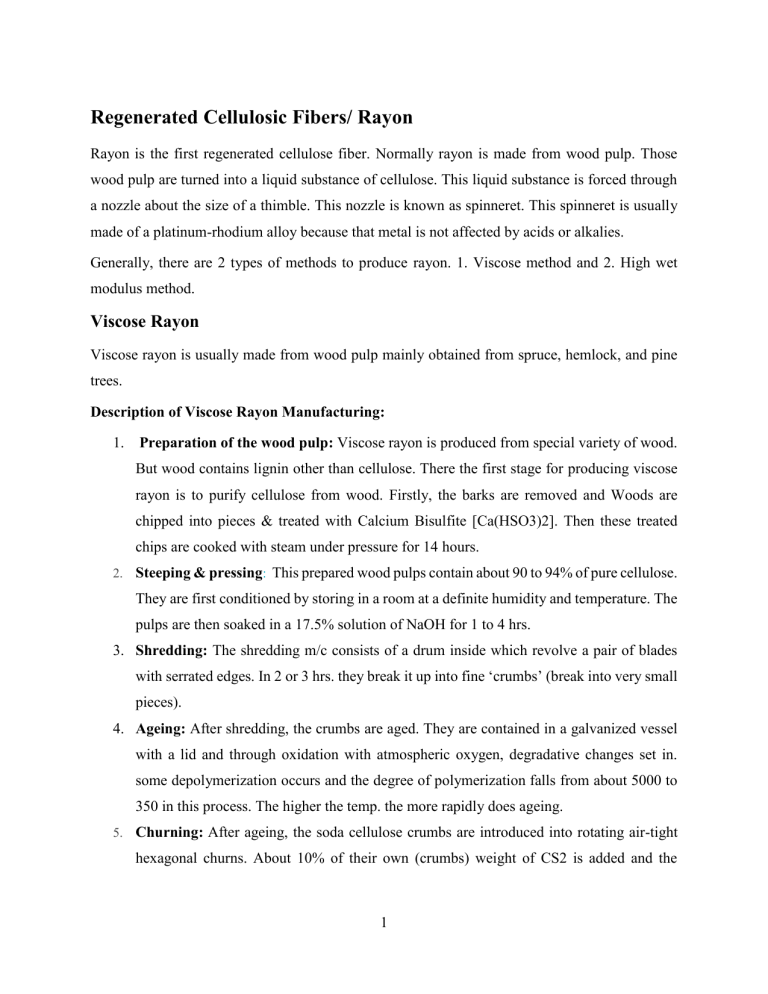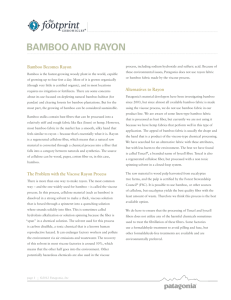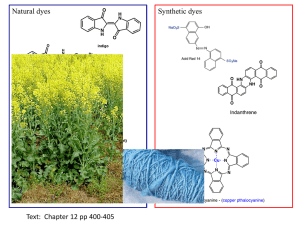
Regenerated Cellulosic Fibers/ Rayon Rayon is the first regenerated cellulose fiber. Normally rayon is made from wood pulp. Those wood pulp are turned into a liquid substance of cellulose. This liquid substance is forced through a nozzle about the size of a thimble. This nozzle is known as spinneret. This spinneret is usually made of a platinum-rhodium alloy because that metal is not affected by acids or alkalies. Generally, there are 2 types of methods to produce rayon. 1. Viscose method and 2. High wet modulus method. Viscose Rayon Viscose rayon is usually made from wood pulp mainly obtained from spruce, hemlock, and pine trees. Description of Viscose Rayon Manufacturing: 1. Preparation of the wood pulp: Viscose rayon is produced from special variety of wood. But wood contains lignin other than cellulose. There the first stage for producing viscose rayon is to purify cellulose from wood. Firstly, the barks are removed and Woods are chipped into pieces & treated with Calcium Bisulfite [Ca(HSO3)2]. Then these treated chips are cooked with steam under pressure for 14 hours. 2. Steeping & pressing: This prepared wood pulps contain about 90 to 94% of pure cellulose. They are first conditioned by storing in a room at a definite humidity and temperature. The pulps are then soaked in a 17.5% solution of NaOH for 1 to 4 hrs. 3. Shredding: The shredding m/c consists of a drum inside which revolve a pair of blades with serrated edges. In 2 or 3 hrs. they break it up into fine ‘crumbs’ (break into very small pieces). 4. Ageing: After shredding, the crumbs are aged. They are contained in a galvanized vessel with a lid and through oxidation with atmospheric oxygen, degradative changes set in. some depolymerization occurs and the degree of polymerization falls from about 5000 to 350 in this process. The higher the temp. the more rapidly does ageing. 5. Churning: After ageing, the soda cellulose crumbs are introduced into rotating air-tight hexagonal churns. About 10% of their own (crumbs) weight of CS2 is added and the 1 crumbs and CS2 are churned up together. As a result, a deep orange gelatinous sodium cellulose xanthate is formed. 6. Mixing: In the mixers, the sodium cellulose xanthate is stirred with dilute caustic soda (NaOH) solution for 4 to 5 yrs., the vessel being cooled. The xanthate dissolves to a clearbrown viscous liquid similar in appearance to honey. This liquid is known as viscose but is still too impure, too young to spin. 7. Ripening: The sodium cellulose xanthate reacts with H2SO4 & form regenerated cellulose. The viscose solution is stored for 4 to 5 days at 10-18®C and during storage it ripens. During the ripening the viscosity at first falls and then rises, so that by the time the solution is ready to spin, the viscosity has risen almost to its original value. 8. Spinning: when the viscose solution is ripe, it is forced to be fed in the spinneret of a spinning unit with additives to form viscose. Bamboo Bamboo is bast fiber like jute, flax, ramie etc. Chemical Composition Cellulose: (70-74) % Hemicellulose: (12-14) % Lignin: (10-12) % Protein, Pectin, Wax etc.: (2-3) % Fig 1: Polymeric Structure of Bamboo Microscopic Appearance Fig 2: Longitudinal View Fig 3: Cross-Sectional View 2 Manufacturing Process There are two methods to manufacture bamboo. Chemical Method Mechanical Method Chemical Method: For making bamboo two chemical method is followed. One is viscose rayon method and other is lyocell processing method. In Viscose rayon method, many chemicals are used which is harmful to environment but still it is the easiest method to produce bamboo fiber. Also, molecular structure of the bamboo changes if produced using this method. On the other hand, Lyocell method is eco-friendly and also don’t alter the structure of the bamboo. Mechanical Method: Bamboo fabric of the highest quality is made with production practices that do not extract cellulose. Instead, a natural enzyme is used on crushed bamboo wood fibers, and these fibers are then washed and spun into yarn. This yarn usually has a silky texture, and the fabric made by this process is sometimes called bamboo linen. It is actually true natural bamboo fiber processing. Advantages of Bamboo Fiber: 1. Green and eco-friendly: As it is 100% cellulosic it is bio degradable in nature 2. Soft & Breathable: Cross section of bamboo fibers are filled with micro gaps and micro pores. So, it has better moisture absorption and ventilation 3. Natural Anti-bacterial Property 4. UV Protection Property Lyocell Lyocell is also regenerated cellulosic fiber like viscose but it is produced in a different method than viscose. In viscose production, normally CS2 (Carbon disulfide) is used which is harmful for environment. But in case of Lyocell, carbon disulfide is not used. So, it is much more sustainable than viscose. 3 Manufacturing Process Preparing the wood pulp The hardwood trees grown for lyocell production are harvested by loggers and trucked to the mill. At the mill, the trees are cut to 20 ft (6.1m) lengths and debarked by high-pressure jets of water. Next, the logs are fed into a chipper, a machine that chops them into squares little bigger than postage stamps. Mill workers load the chips into a vat of chemical digesters that soften them into a wet pulp. This pulp is washed with water, and may be bleached. Then, it is dried in a huge sheet, and mill workers roll it onto spools. The sheet of cellulose has the consistency of thick posterboard paper. The roll of cellulose is enormous, weighing some 500 lb (227 kg). Dissolving the cellulose At the lyocell mill, workers unroll several spools of cellulose and break them into one-inch squares. The workers then load these squares into a heated, pressurized vessel filled with amine oxide. Filtering After a short time soaking in the solvent, the cellulose dissolves into a clear solution. It is pumped out through a filter, to insure that all the chips are dissolved. Spinning Next, the solution is pumped through spinnerets. These are devices used with a variety of manmade fibers. Something like a showerhead, the spinneret is pierced with small holes, and when the cellulose is forced through it, long strands of fiber come out. The fibers are then immersed in another solution of amine oxide, diluted this time. This sets the fiber strands. Then, they are washed with de-mineralized water. Drying and finishing The lyocell fiber next passes to a drying area, where the water is evaporated from it. The strands at this point pass to a finishing area, where a lubricant is applied. This may be a soap or silicone or other agent, depending on the future use of the fiber. This step is basically a detangler, making the future steps of carding and spinning into yarn easier. 4 Final steps The dried, finished fibers are at this stage in a form called tow. Tow is a large untwisted bundle of continuous length filaments. The bundles of tow are taken to a crimper, a machine which compresses the fiber, giving it texture and bulk. The crimped fiber is carded by mechanical carders, which perform an action like combing, to separate and order the strands. The carded strands are cut and baled for shipment to a fabric mill. The entire manufacturing process, from unrolling the raw cellulose to baling the fiber, takes only about two hours. After this, the lyocell may be processed in a wide assortment of ways. It may be spun with another fiber, such as cotton or wool. The yarn can be woven or knit like any other fabric, and given a variety of finishes, from soft and suede-like to silky. Recovery of the solvent The amine oxide used to dissolve the cellulose and set the fiber after spinning is recovered and reused in the manufacturing process. The dilute solution is evaporated, removing the water, and the amine oxide is routed for re-use in the pressurized vessel in step 2. Ninety-nine percent of the amine oxide is recoverable in the typical lyocell manufacturing process. Brand Lyocell was trademarked as “Tencel” in 1982. Other than Tencel, Lyocell has different trademark names. Such as Lenzing Lyocell (Lenzing) Newcell(Akzo Nobel) Seacell (Zimmer AG) Excel (Birla) 5


